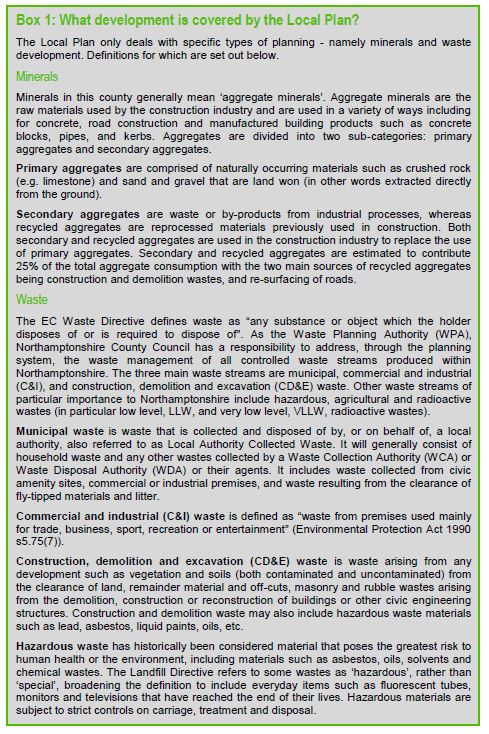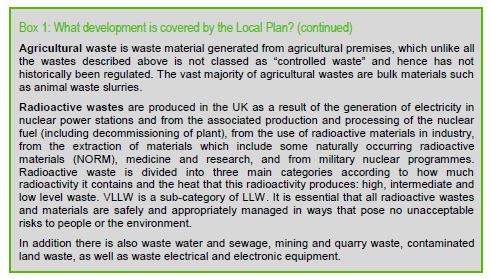1. ABOUT THE NORTHAMPTONSHIRE MINERALS AND WASTE LOCAL PLAN
The Northamptonshire Minerals and Waste Local Plan, or the Local Plan, is the land use planning strategy for minerals and waste related development in the county. It provides the basis for investment in new minerals and waste development in Northamptonshire, and where in the county it should go to.
The Local Plan identifies what minerals and waste related development should go where, why it should go there, and how by doing so, it can make other land use and infrastructure systems function better. It considers the impact and design of new minerals and waste development, and focuses on how this development can best relate to the surrounding land use and link with the wider community.
It is also intended to act as a driver for new investment and identifies how investment in minerals and waste development can be optimised for everyone’s benefit. It focuses, and where appropriate, integrates minerals and waste development activity and investment with other development and investment in the county. As such it is referred to as a ‘spatial plan’.
The adopted Local Plan provides the basis for determining planning applications for, or covering, minerals and waste related development in Northamptonshire. It sets out:
- the broad strategy for minerals and waste related development in the county and the amount of provision we will need to make for such development,
- the long-term vision for minerals and waste related development in Northamptonshire to 2031,
- the plans objectives, required to realise the vision,
- policies addressing the control and management of development such as development criteria and locally specific issues (such as co-location of waste management facilities with new development, sustainable use of resources, addressing potentially adverse effects, Mineral Safeguarding Areas, preventing land use conflict, design and layout, and restoration),
- site-specific allocations for minerals-related development, and
- locations for waste-related development, including site-specific allocations.
The Local Plan also contains a separate Policies Map which identifies the sites and policies (where possible) on a detailed OS map of the county.
The Development and Implementation Principles Supplementary Planning Document (SPD) accompanies the Local Plan. The SPD provides practical guidance concerning all other forms of development (such as waste minimisation and management and preventing land use conflict), as well as those specific to minerals and waste development (such as catchment areas, addressing potentially adverse effects, design and restoration).
The plan period is from 2011 to 2031 (1 January 2011 to 1 January 2031), a period of twenty years.
There are also two related documents to the Local Plan:
- The Statement of Community Involvement (SCI), which sets out how the County Council will consult and engage with people during the preparation of the Local Plan as well as on significant planning applications submitted to the County Council.
- The Minerals and Waste Monitoring Report (MWMR), which monitors how the County Council is progressing with the Local Plan, and particularly how its policies are being implemented. This is to be produced annually.
The Local Plan, along with those prepared by the district planning authorities in Northamptonshire (including the joint planning committees) form the Development Plan for the area.


Planning law requires that applications for planning permission must be determined in accordance with the Local Plan unless material considerations indicate otherwise. The government’s National Planning Policy Framework (NPPF) has the presumption in favour of sustainable development as its fundamental component.
In preparing the Local Plan this means that:
- Planning authorities should positively seek opportunities to meet the development needs of their area;
- Local Plans should meet objectively assessed needs, with sufficient flexibility to adapt to rapid change, unless any adverse impacts of doing so would significantly and demonstrably outweigh the benefits, when assessed against the policies in the NPPF taken as a whole, or specific policies in the NPPF indicate development should be restricted.
In making decisions on planning applications proposals that accord with the Local Plan should be approved without delay. Where the Local Plan is silent or the relevant policies are out-of-date permission should be granted unless any adverse impacts of doing so would significantly and demonstrably outweigh the benefits, when assessed against the policies in the NPPF taken as a whole, or specific policies in the NPPF indicate development should be restricted.
The role of the Local Plan
The Local Plan is applicable to all proposals for minerals and waste related development, and all other forms of development, made in Northamptonshire. This is regardless of whether or not the proposal relates to an allocated site (or location) identified in the Local Plan or to any other site.
In developing proposals, and for the County Council to determine them, the policies in the Local Plan should not be read in isolation. Rather they are intended to be read in conjunction with national planning policy and legislation as well as european legislation and directives.
The general intention of the new planning system is that where a national policy does not require specific local amplification, there is no need for repetition. On the other hand, where the plan is silent on issues there is a presumption in favour of sustainable development (where in compliance with national policy). Therefore we need to capture locally specifc issues at the right level and identify potential future issues in order to deliver the vision for Northamptonshire.
The Local Plan addresses:
- The spatial strategy, development principles and allocations for minerals and waste related development.
- Local planning considerations such as the built and natural environment, design, restoration, Mineral Safeguarding Areas and preventing land use conflict. These locally specific matters need to be considered in determining proposals for minerals and waste development (regardless of whether a proposal is for an allocated site or not), as well as proposals for all other forms of development. These key areas do not reiterate the detail of national policy but act as signposts and give a Northamptonshire specific context.
The Local Plan allocates sites for minerals and waste related development within the county. For minerals this includes specific sites for the extraction of sand and gravel, crushed rock (limestone), other mineral extraction and facilities. For waste this includes specific industrial locations where waste management uses would be acceptable in principle and sites for waste management facilities.
Site specific allocations take the vision, objectives, spatial strategy and other policies forward to ensure delivery of the:
- required aggregate provision, thus maintaining landbanks to ensure an adequate supply of aggregates for the construction industry over the plan period, and
- required waste management and disposal capacity to support growth within Northamptonshire throughout the plan period.
In all cases any proposed development will be expected to comply with relevant parts of the Local Plan, in particular the spatial strategies for minerals and waste related development. Furthermore, proposals for allocated sites should be in accordance with other policies set out in the Local Plan.
Implementation and monitoring of the plan
The Local Plan also includes a framework for implementing and monitoring the effects of the plan. The monitoring framework is closely linked to that of the Sustainability Appraisal and focuses on planning outcomes (i.e. planning applications granted, compliance with developer requirements as well as annual aggregates provision and waste managment / disposal capacity).
Sustainability and environmental assessment of the plan
The Local Plan has undergone both a Sustainability Appraisal (SA) and a Habitats Regulations Assessment (HRA).
When preparing planning documents, such as the Local Plan, planning authorities must conduct an environmental assessment in accordance with the requirements of European Directive 2001/42/EC. This must include an "assessment of the effects of certain plans and programmes on the environment" (the Strategic Environmental Assessment or SEA Directive). SA effectively broadens the concept of SEA to encompass economic and social impacts. The requirement to carry out SA and SEA are distinct. However, it is possible to satisfy both through a single appraisal process. It should be noted that where reference is made to SA it should be taken to include the requirements of the SEA Directive. The integration of sustainability considerations into the preparation and adoption of Plans is the key focus of the SA process.
HRA is required under the European Directive 92/43/EEC on the conservation of natural habitats and wild fauna and flora for plans that may have an impact on European Sites (Natura 2000). The Upper Nene Valley Gravel Pits Site of Special Scientific Interest (SSSI) is designated a Special Protection Area (SPA), which is a European Site. HRA is therefore required for the Local Plan in order to consider the impact of the plan against the conservation objectives of the site and ascertain whether the plan would adversely affect the sites integrity.